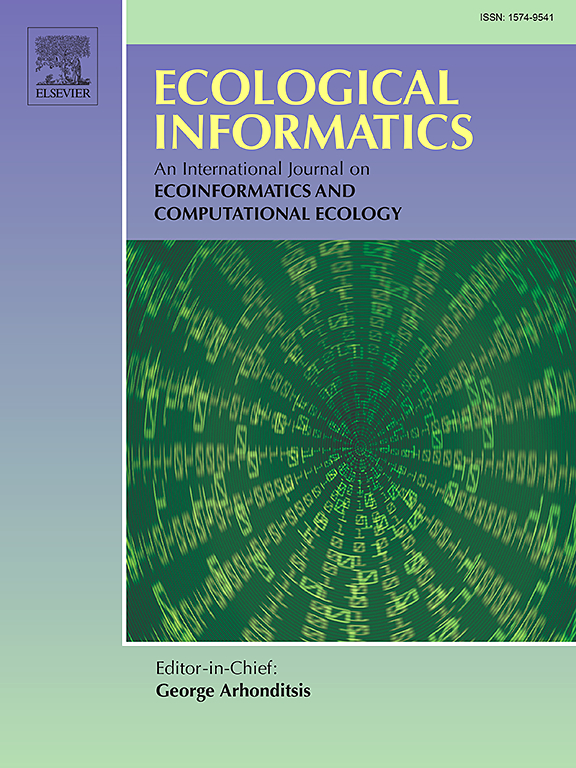Refining landsat-based annual NDVImax estimation using shape model fitting and phenological metrics
IF 5.8
2区 环境科学与生态学
Q1 ECOLOGY
引用次数: 0
Abstract
The annual maximum normalized difference vegetation index (NDVImax) is widely used as a surrogate for annual aboveground net primary productivity (ANPP) of summer-green vegetation. Landsat data, with its 30-m spatial resolution and high temporal consistency, have revealed long-term changes in NDVImax and ANPP. However, in cloudy regions with summer-green vegetation, such as the Tibetan Plateau, the scarcity of cloud-free Landsat NDVI observations complicates NDVImax estimation, particularly due to interannual variations in phenology and NDVImax. This study proposed a shape model fitting method that integrates interannual phenological similarity to estimate Landsat NDVImax, using the Tibetan Plateau as an example. For a given target year, an annual NDVI shape model was constructed using all cloud-free Landsat NDVI observations from that year and phenologically similar years, identified using phenological metrics derived from MODIS and GIMMS NDVI datasets. The model was then fitted to the target year's cloud-free NDVI time series to correct seasonal biases in NDVI observations. Validations with simulated and real images indicated that the proposed method outperformed several commonly used approaches in estimating NDVImax and detecting temporal trends across various conditions. The method more accurately captured the true annual NDVI trajectory and NDVImax date for the target year. It enabled the retrieval of long-term high-resolution NDVImax series for summer-green vegetation on the Tibetan Plateau and provided a reference for Landsat NDVImax extraction in other summer-green vegetation regions. Additionally, by addressing the observational biases, the method corrected previous overestimates of greening on Tibetan Plateau, thereby improving global change studies on summer-green vegetation.
使用形状模型拟合和物候指标改进基于陆地卫星的年度NDVImax估算
年最大归一化植被指数(NDVImax)被广泛用作夏绿植被年地上净初级生产力(ANPP)的替代指标。Landsat数据具有30 m空间分辨率和高时间一致性,揭示了NDVImax和ANPP的长期变化。然而,在夏季绿色植被的多云地区,如青藏高原,缺乏无云的Landsat NDVI观测使NDVImax估算复杂化,特别是由于物候和NDVImax的年际变化。本文以青藏高原为例,提出了一种整合年际物候相似性的Landsat NDVImax形状模型拟合方法。对于给定的目标年,使用该年和物候相似年的所有无云Landsat NDVI观测数据构建年度NDVI形状模型,并使用来自MODIS和GIMMS NDVI数据集的物候指标进行识别。然后将该模型拟合到目标年的无云NDVI时间序列中,以纠正NDVI观测中的季节偏差。模拟和真实图像的验证表明,该方法在估计NDVImax和检测各种条件下的时间趋势方面优于几种常用方法。该方法更准确地捕获了目标年的真实年度NDVI轨迹和NDVImax数据。实现了青藏高原夏绿植被长期高分辨率NDVImax序列的检索,为其他夏绿植被区域的Landsat NDVImax提取提供了参考。此外,通过解决观测偏差,该方法纠正了以往青藏高原绿化的高估,从而改善了夏季绿色植被的全球变化研究。
本文章由计算机程序翻译,如有差异,请以英文原文为准。
求助全文
约1分钟内获得全文
求助全文
来源期刊

Ecological Informatics
环境科学-生态学
CiteScore
8.30
自引率
11.80%
发文量
346
审稿时长
46 days
期刊介绍:
The journal Ecological Informatics is devoted to the publication of high quality, peer-reviewed articles on all aspects of computational ecology, data science and biogeography. The scope of the journal takes into account the data-intensive nature of ecology, the growing capacity of information technology to access, harness and leverage complex data as well as the critical need for informing sustainable management in view of global environmental and climate change.
The nature of the journal is interdisciplinary at the crossover between ecology and informatics. It focuses on novel concepts and techniques for image- and genome-based monitoring and interpretation, sensor- and multimedia-based data acquisition, internet-based data archiving and sharing, data assimilation, modelling and prediction of ecological data.
 求助内容:
求助内容: 应助结果提醒方式:
应助结果提醒方式:


